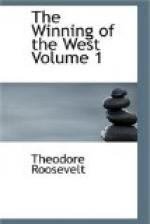In summer they wore buckskin shirts and breech-clouts; in winter they were clad in the fur of the bear and wolf or of the shaggy buffalo. They had moccasins of elk or buffalo hide, and high thigh-boots of thin deer-skin, ornamented with fawns’ trotters, or turkey spurs that tinkled as they walked. In their hair they braided eagle plumes, hawk wings, or the brilliant plumage of the tanager and redbird. Trousers or breeches of any sort they despised as marks of effeminacy.
Vermilion was their war emblem; white was only worn at the time of the Green-Corn Dance. In each town stood the war pole or painted post, a small peeled tree-trunk colored red. Some of their villages were called white or peace towns; others red or bloody towns. The white towns were sacred to peace; no blood could be spilt within their borders. They were towns of refuge, where not even an enemy taken in war could be slain; and a murderer who fled thither was safe from vengeance. The captives were tortured to death in the red towns, and it was in these that the chiefs and warriors gathered when they were planning or preparing for war.
They held great marriage-feasts; the dead were buried with the goods they had owned in their lifetime.
Every night all the people of a town gathered in the council-house to dance and sing and talk. Besides this, they held there on stated occasions the ceremonial dances; such were the dances of war and of triumph, when the warriors, painted red and black, returned, carrying the scalps of their slain foes on branches of evergreen pine, while they chanted the sonorous song of victory; and such was the Dance of the Serpent, the dance of lawless love, where the women and young girls were allowed to do whatsoever they listed.
Once a year, when the fruits ripened, they held the Green-Corn Dance, a religious festival that lasted eight days in the larger towns and four in the smaller. Then they fasted and feasted alternately. They drank out of conch-shells the Black Drink, a bitter beverage brewed from the crushed leaves of a small shrub. On the third day the high-priest or fire-maker, the man who sat in the white seat, clad in snowy tunic and moccasins, kindled the holy fire, fanning it into flames with the unsullied wing of a swan, and burning therein offerings of the first-fruits of the year. Dance followed dance. The beloved men and beloved women, the priest and priestesses, danced in three rings, singing the solemn song of which the words were never uttered at any other time; and at the end the warriors, in their wild war-gear, with white-plume headdresses, took part, and also the women and girls, decked in their best, with ear-rings and armlets, and terrapin shells filled with pebbles fastened to the outside of their legs. They kept time with foot and voice; the men in deep tones, with short accents, the women in a shrill falsetto; while the clay drums, with heads of taut deer-hide, were beaten, the whistles blown, and the gourds and calabashes rattled, until the air resounded with the deafening noise.[24]




